On page one the paper’s editor, Charles Kihega (Iowa) wrote a letter about his successful journey home. Metopah (Osage), Taylor Ealy (Pueblo), and Frank Everett (Wichita) also wrote letters from their outing locations back to the school. On page two eight boys and twelve girls took a trip to explore Luray Cave. Also on the same page Van Horn (…
Pueblo
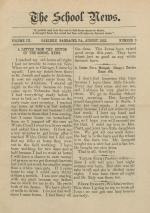

The first page had a story told to Joshua Given (Kiowa) by his grandparents about a young girl who never touched the ground and one day chased a star into the sky. It also included a letter from Louis Big Horse (Osage) to his father in which he discussed planting fruit. Page two had an article titled “What Indians Must Have” by paper editor…

Page one opened with an article titled “Strong Words for the Indians From Commissioner Price”, along with “A Plea for Civilized Indians”, “Two Pueblo Boys”, and “The Baby”. Page two had Captain Pratt’s account of his visit to the west. It also had comments from various chiefs on their opinion on Carlisle. Finishing up the page were comments on…

Page one opened with Proverb 11:23. Also on he page was “Educating The Indians”, and a Pueblo legend as told by a Pueblo student. Page two had story about a foolish farmer, as well as an important letter from an Indian Agent, and a piece on a conference at Lake Mohonk. Page three had the School Items which included Sunday services and the…
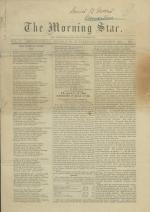
Page one had a poem titled “Lady Yeardley’s Guest” by Margaret Preston, followed by a report of the commissioner of Indian Affairs, which continued onto page two, and then onto page three, where it ended. After the finish of the report, page three had articles titled “The Up-Thrust of Civilization”, “Don’t Wait for the Others”, and “The Big…
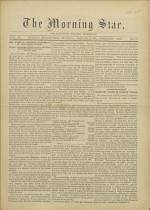
Page one opened with an extract from Hon. Byron M. Cutcheon speech, “Our Indian Policy,” originally given to the House of Representatives. Following that was “Secretary Teller in Favor of Schools.” Page two had a list of Bills and Resolutions relating to Indians that went before congress recently. Also on Page two was a letter from a Carlisle…
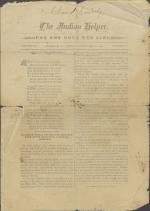
The first page opened with a poem titled “New Every Morning,” followed by "An Indian Woman Fought For Her Husband After Receiving a Beating From Him" which concluded on the fourth page. Page two gave news from the Chemawa and Genoa Indian Schools, and "A Nice Pocket Book for the Best," asking for wish lists from the trade departments. Next came…
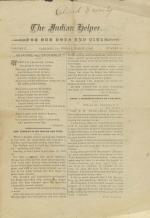
The first page opened with a poem titled “So Say We, All of Us Girls,” followed by “The Indian’s Hair Would Not Curl,” by Aunt Martha that recalled a comical hair care story involving Aunt Martha’s friend and a visiting Indian chief. “From a Former Student of Carlisle” reprinted a letter to Capt. Pratt from former student Frank Aveline (Miami)…
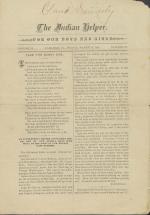
The first page opened with a poem titled “Take the Sunny Side,” by “Ex.” Also found on that page was “An Interesting Letter from John Dixon, One of Our Pueblo Boys Who Went to His Home in New Mexico Last Summer” addressed to Mr. Campbell. Dixon wrote about celebrating George Washington’s birthday, looking for railroad work and visiting the…

The first page opened with a poem titled “The Boy and the Bird,” author undetermined. The next article was titled “How the Indian School Girls in Sitka, Alaska, Got Ahead of the Indian Boys,” which concluded on the fourth page. Page two contained articles about returned students, John Davis (Pueblo) writing from his country home, and a piece…
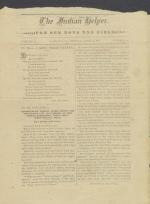
The first page opened with a poem titled “To Tell a Good House-Keeper,” reprinted from The New Moon. Also on the page was an account by Johnnie Schmoker about bird hunting at the Cheyenne and Arapaho School in Oklahoma titled “INCIDENTS OF SCHOOL WORK AMONG THE CHEYENNES AND ARAPAHOES, IN THE INDIAN TERRITORY, WHEN THEY WERE REALLY…
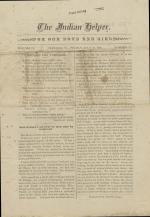
This issue opened with a poem titled “THROUGH AND THROUGH” reprinted from Scattered Seeds.” Also found on that page was “MISS WILSON’S ACCOUNT OF HER TRIP TO SCOTLAND,” a travelogue of the teacher and her sister’s visit by ocean liner to Scotland and Ireland and back. Page two opened with “A Child’s Wise Speech,” that described the…
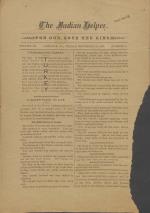
The first page opened with a poem, "Thanksgiving Turkey," a play on the letters in the word "Turkey" followed by a description of the Acoma Pueblo by student Annie Thomas, entitled "A Queer Place To Live." This also was a subject of the article written about the monthly exhibition on page 3. The second page included news of students who…
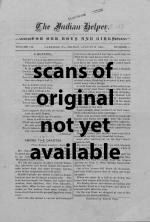
The first page opened with the poem, " A Proverb," followed by Jemima Wheelock's (Oneida) report of "Our Wilmington Trip," about a group of students traveling to Delaware where they stayed with families before they headed to Philadelphia with Capt. Pratt and Miss Leverett. They visited John Wannamaker's Store, the zoo, an iron factory and…
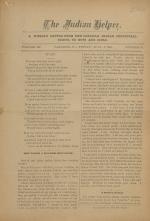
The first page opened with a poem by Sarah E. Eastman reprinted from “Golden Days,” titled “If! If!” followed by the reprinted letter from a Carlisle Indian School student on Outing called “She Wants a Higher Education.” The last piece on the page continues on the fourth page called “A Modern Pueblo” about the process by which a progressive…
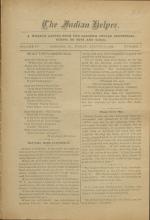
The first page opened with the poem, “What the Flowers Said,” followed by an article reprinted from The Baltimorean, titled "Men Who Were Laughed At,” about how technologies were first spurned. Page two featured several news reports about the band, outing experiences, news from the Rosebud Sioux and Osage Agencies, and an entire column…
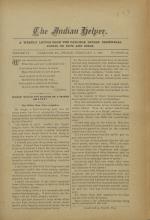
The first page began with an untitled poem that opened with the first line “We can never be too careful,” followed by “Which Would You Rather Be a Spider or a Fly? / The White Man Like a Spider,” an account of Mr. Seger’s description of the idiosyncrasies of language translation. It continued on the fourth page. Page two featured news articles…
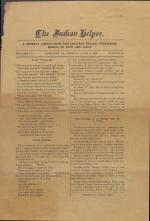
The first page began with a poem titled, “The Tongue,” followed by the Man-on-the-band-stand’s discussion in “Never Before,” that explained that a horde of boys would be marching east toward opportunity but a horde of boys would be marching west toward degradation, which he described as “evil practices and rot.” The page continued with “The…
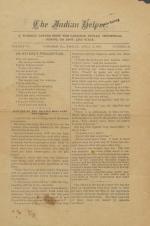
The first page began with a poem titled, “Dr. Nature’s Prescription,” followed by “How One of the Printer Boys Came Out Ahead,” which described how a printer, against the advice of his instructor, was able to repair faulty equipment using his own problem solving technique. This was followed by a short blurb warning against smoking. Page two…
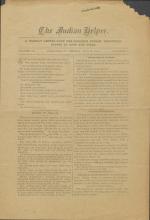
The first page began with an untitled poem with a first line of “God gave us hands – one left one right,” followed by an article describing the seeds of success titled “When It Tells.” The next article was about the Ayan Indians who fish salmon on the Yukon River titled “Sharp-sighted Indians,” followed by a treatise on politeness. Page two…
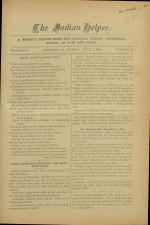
The first page opened with a poem by Susan Coolidge titled “New Every Morning,” followed by a letter from Ernie Black (Cheyenne) titled “News from our Cheyenne and Arapahoe Boys.” Also on the page was a reprint from The Sunday School Times titled “We Must Be Run Through a Mill.” Page two opened with a quote from Paul Boynton (Arapho)…

The first page opened with a poem by Fannie Bolton titled “It is Time,” followed by “The Experience of a Bull: A Child’s Version of the Recent Flood at Lewistown,” followed by “A Busy Indian Boy in the Country” which was Wallace Scott’s (Pueblo) description of his farm experience in Bucks County. Page two featured a notice of the new premium…

The first page opened with a poem “Cherries Are Ripe,” from Youth’s Companion, followed by a story titled “Sebastian’s Opportunity” about the training of a painter named Sebastian Gomez, a.k.a. “The mulatto of Murillo.” Page two featured a piece called "In Vacation," in which the Man-On-The-Band-Stand invited students to share their…
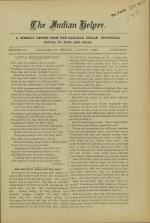
The first page opened with a poem “Little Moccasined Feet,” followed by the article titled “How Did There Come to be Any Coal?” that described the origin of coal. Page two opened with “Small Beginnings,” a litany of how Benjamin Franklin, Columbus, and others had their origins. “How One Conquers,” followed by “Luck and Labor,” as well as…
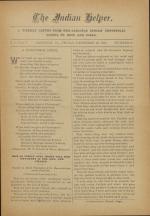
The first page opened with a poem titled "A Christmas Carol by Eleanor W.F. Bates in Home Magazine. Next came a new installment of the series titled “How An Indian Girl Might Tell Her Own Story if She Had the Chance: Founded on Actual Observations of the Man-on-the-band-stand’s Chief Clerk” (continued from the previous week). In this…
